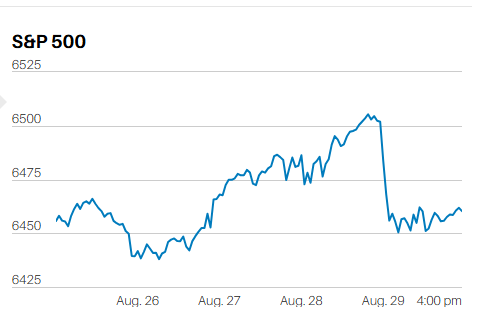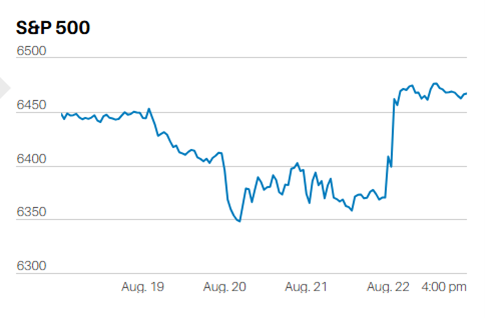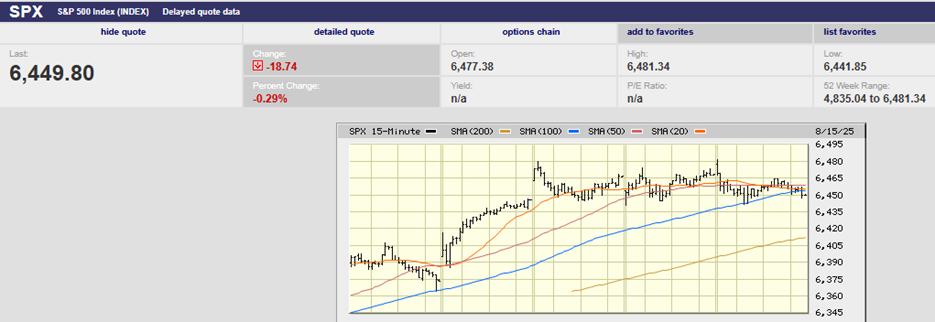
Market Update
The S&P 500 gained 2.6% last week to finish at 3961.63. The Nasdaq rose 3.3%. The S&P hit its 4012.44 high for the week early Friday morning. We wrote last week that, “The S&P needs to push through 3918.5 (the 8 July high) followed by the 50-day moving average at 3940. Resistance at 3945.86 is next. Only then can the S&P take a run at 4177.” The index conquered 3945.86 last week, managing to close above it on Friday. A run at 4177 is unlikely though without some profit taking first. The index is short-term overbought.
The S&P could move higher immediately but a pullback is more likely first. The index needs to hold its 3721.56 July 14th low to maintain its upside bias. A breach of 3721.56 opens the door to a retest of the 3636.87 June 17th low. Regardless of near-term direction, the index will likely tread water until after the FOMC press conference Wednesday afternoon. We will see if the press conference is spun as a positive by investors or used as an excuse to lock in profits. The downside is more likely this week based on the technical setup.
The long-term trend is still down. The 200-day moving average is at 4355 and is descending. The Federal Reserve may disappoint Wednesday by signaling aggressive rate hikes to come. Earnings may disappoint this week as several big tech companies report. The stock market is entering its weakest months, especially in years of U.S. midterm elections, according to Rich Ross of Evercore ISS. In short, the selling may resume this week. Or it may not because…
Investor sentiment is very bearish. A BofA Securities survey of almost 300 fund managers managing almost $800 billion in assets reflects such deep pessimism that BofA strategists see capitulation, according to Barron’s. The survey shows that equity fund managers’ cash holdings are at 6.1%. It is the highest level since October 2001, right after 9/11. The survey also showed that a large percentage of respondents are underweight stocks.
The S&P is trading at approximately 16.0x 2023 earnings which is near its long-term average. There are two things to keep in mind, however. First, earnings estimates are likely too high and will not live up to expectations. Second, bear markets rarely end with markets at fair value. Rather bear markets end with stock markets at or near single price-to-earnings multiples. The S&P may continue to rally back to 4200 but it is unlikely that the bear market is over.
Economic Indicators
Approximately 15% of the economy is tied to the housing market. The housing market is one of the most interest rate-sensitive markets. Homes sales have dropped in the last few months. Existing home sales in the U.S. dropped 5.4% in June 2022. It is a new low since June 2020 and below market forecasts. The NAHB home builders’ index fell to 55 in July from 67. The forecast was for 66. Housing starts dropped to 1.56 million from 1.59 million in June. Existing home sales fell to 5.12 million in June from 5.41 million.
Leading economic indicators were negative 0.8% in June down from negative 0.6% in May. The Fed manufacturing index was negative 12.3 in July down from negative 3.3 the prior month. More bad news came from the S&P Global U.S. services PMI which declined to 47 in July from 52.7 in June. A number below 50 shows contraction. The Atlanta Fed GDPNow forecast is for negative 1.6% GDP growth in Q2, the same as in Q1.
We are likely already in a recession. Norwood Economics is forecasting a shallow recession followed by several quarters of expansion. We see the economy falling back into recession in 2023 as QT and interest rate hikes bite. The bond market may be signaling the same as the 10-year Treasury is now at 2.80% down from 3.50% earlier this year.
Performance and Poor Decisions
Measuring performance is tricky. Often people end up comparing apples to oranges. An all-stock portfolio should not be compared to an all-bond portfolio for instance. Nor should a portfolio that contains international and emerging market stocks be compared to the S&P 500. An international stock portfolio should be compared to an international index. A U.S. large-cap stock portfolio should be compared to the S&P 500 or the Russell 1000. A small-cap stock portfolio should be compared to the S&P 600 Small Cap Index or the Russell 2000. Comparing apples to oranges is the number one mistake investors make when assessing performance in my experience.
Measuring performance over different time periods is another common mistake. I had a client who was angry that his portfolio with us wasn’t doing as well as a portfolio he’d inherited from his mom. There were a couple of problems with his analysis, including mismatched time periods. The period in question was 2020. He was looking at his mom’s portfolio from June through October of 2020. He was looking at his portfolio with us from January through October of 2020. The stock market fell almost 35% in February and March 2020. His analysis of relative performance suffered greatly because of the mismatched time periods.
He was also comparing apples to oranges. His portfolio with us was about 50% stock and 50% bonds. His mom's portfolio was around 74% stock. We had him in high-quality companies that paid nice dividends. A low-risk approach to stock investing that he’d wanted. His mom's portfolio had a big dose of technology in it. His mom's portfolio was heavily exposed to the likes of AAPL, MSFT, NVDA, AMZN, and META. The technology sector had a nice run from 2018 through 2021. It has been clobbered in 2022.
His poor analysis is costing him this year. He left us because of his misunderstanding of how to measure performance. Our clients are up on the year. His mom's portfolio almost certainly is not. It is also likely that he sold our stocks and invested even more in what he thought was "working" at the time. His losses in 2022 are even higher if he did.
Yet another common mistake is forgetting to account for deposits and withdrawals. I had a client reach out to me last week. She wanted to suspend new contributions into her account until the stock market settled down. Turns out she thought she’d lost $40,000 on the year. Her portfolio is up about 1% YTD and her stocks are up around 6% on the year. The problem? She’d forgotten about the withdrawals she’d made. It often works the other way as well. Individual investors usually forget to account for deposits they’ve made during the year. Consequently, they believe their performance is better than it was.
Making good investment decisions is difficult enough even with good data. It becomes downright impossible to make good decisions if the data isn’t accurate or is benchmarked incorrectly. Poor performance analysis also makes it hard to hold your financial advisor accountable. Most people I talk to have no real understanding of whether their advisor is adding value or not. Ignorance is not bliss when investing. Make sure you understand how to measure your portfolio’s performance. It will help you be a better investor.
Regards,
Christopher R Norwood, CFA
Chief Market Strategist











